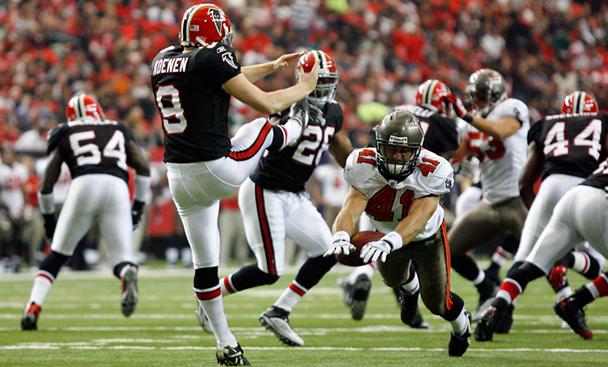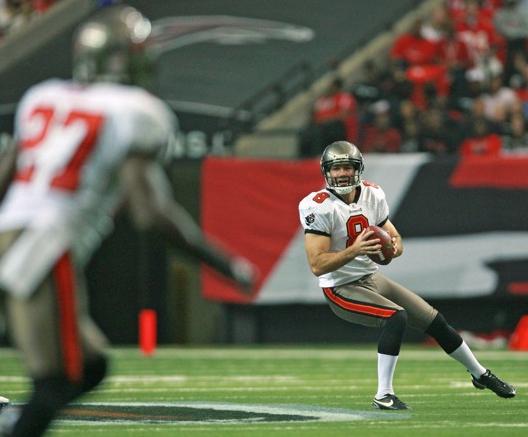|
|
 |
 Stephen Holder, The St.Petersburg Times, published 30 November 2009
Stephen Holder, The St.Petersburg Times, published 30 November 2009
Bucs special teams coordinator Rich Bisaccia gave S Corey Lynch the go-ahead to go after Michael Koenen's punt 3:00 into the third quarter, seeing an opportunity to take advantage of Lynch's little-known specialty.
Though he plays sparingly on defense, Lynch is quite adept at blocking kicks of all kinds. He blocked six while at Appalachian State, including the field goal that sealed the famous upset of Michigan in 2007. Sunday, he blocked Koenen's punt and recovered it at the Atlanta 8.
That set up RB Cadillac Williams' touchdown reception two plays later. "I just got a good jump on it, and I was there before I knew it," said Lynch, who was signed off of the Bengals' practice squad on Sept. 23.
"I was very fortunate to have some blocks in college, and it's continued into the NFL. I'm just thankful to God for the opportunity. I really enjoy that part of special teams." It was the fifth blocked kick for the Bucs this season: two punts, two extra points and one field goal.
Balancing act
WR Maurice Stovall continued his standout play on special teams when he went airborne into the end zone to bat a punted ball back into the field of play. That's where long snapper Andrew Economos and CB Torrie Cox managed to corral the ball with soft hands, eventually downing it inside the Falcons 1 on the fourth quarter's first play. Atlanta challenged the ruling, but it was determined Economos did not touch the goal line while touching the ball.
"We know the rule is that you have to touch the ball without touching the end zone first," Stovall said. "Me and the other fliers, we practice that every Thursday, and we carry it over into the game. We also had a great kick by our punter (Dirk Johnson)."
After Stovall's save, it became something of a bucket brigade-like chain. Economos was next, slapping the ball between his legs. Then Cox, who had initially stepped into the end zone, came out and re-established position in the field of play before finally downing the ball.
It was pretty much textbook stuff. "If we're kicking a red zone punt, we're trying to get it inside the 10," Economos said. "Inside the 20 is great, but inside the 10 is better, especially inside the 1. You're not going to have too many shots at that."
 Fake punt flops
Fake punt flops
The decision itself will be debated for quite some time. But Tampa Bay's fake punt 2:01 into the fourth quarter was not supposed to look anything like the fire drill it appeared to be. It has been in the playbook for quite a while, and it has been practiced on a regular basis. The problem, as with any play call, is teams cannot predict how defenses will react.
In this case, the Falcons showed discipline, several converging on RB Clifton Smith, left, P Dirk Johnson's primary target. When Johnson took the snap and rolled right, he realized the play wouldn't work as designed. At that point, it became an instinctual situation. Johnson initially thought about running for a first down, believing he might be able to pick up the necessary 8 yards. But …
"The (defender) came upfield, and I knew I didn't have the corner. So I just cut back, and I stopped and threw it," said Johnson, who injured his hamstring on the play and did not return.
At that point, the only potential target was TE John Gilmore, who had veered toward the middle of the field but had two defenders draped over him. The ball was swatted away, though Gilmore appeared to get a finger or two on it. "He did a good job just to get it to me," Gilmore said of Johnson, "because he had nothing."
|

|
|
| |
| |
|